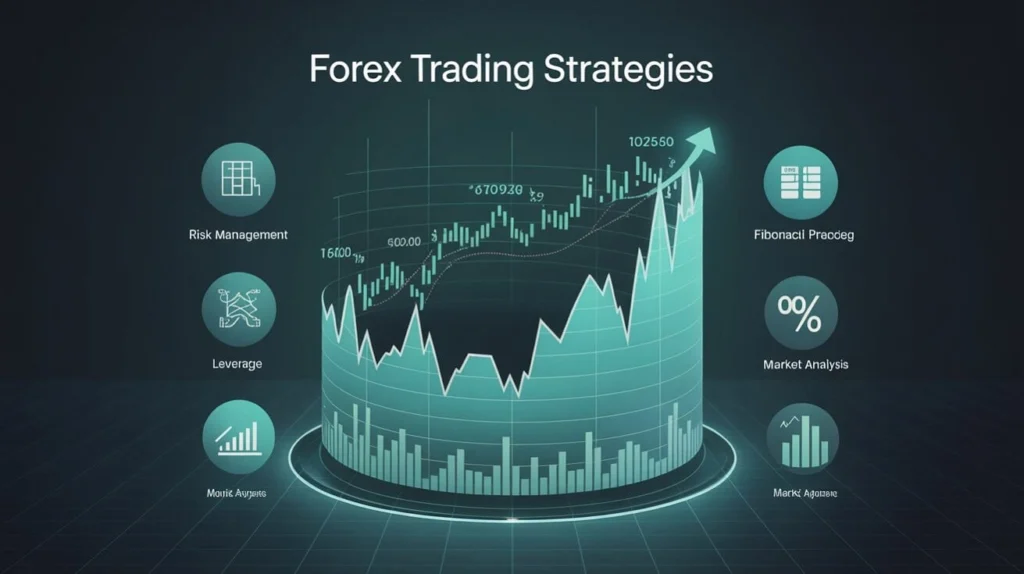In the ever-evolving global currency markets, success often hinges on having a reliable and well-tested game plan. Forex trading strategies serve as a structured method to approach market analysis, time trades, and manage risks. Whether you’re a beginner learning the ropes or a seasoned trader refining your tactics, a defined strategy not only guides your decisions—it helps protect your capital.
This comprehensive guide covers how to build a personalized forex trading strategy, explores the most effective techniques used in the market today, and outlines how tools like technical analysis, fundamental analysis, and forex signals can enhance your performance.

Content
What Is a Forex Trading Strategies?
At its core, a forex trading strategies is a systematic plan for executing trades in the foreign exchange market. It outlines when to enter or exit a trade, how to size your positions, and what criteria must be met before acting.
Some strategies are based purely on price action and chart patterns, while others integrate economic indicators, interest rate data, or algorithmic models. A sound strategy minimizes emotion and adds structure to trading, which is essential in such a volatile and high-leverage environment.
How to Develop Your Own Forex Trading Strategy
While pre-built systems are widely available, creating a custom strategy offers a better fit for your lifestyle and goals. Here’s how to approach it:
- Know your preferred style: Do you prefer making quick decisions as a scalper, holding trades overnight as a swing trader, or building positions over weeks as a position trader?
- Choose your preferred currency pairs: Different currency pairs exhibit different behaviors. Major pairs like EUR/USD or USD/JPY offer high liquidity, while exotics may present higher volatility and wider spreads.
- Understand your risk tolerance: Are you comfortable with high drawdowns for the chance of large profits, or would you prefer conservative gains with minimal risk?
- Decide how much you want to trade: Determine the capital you can allocate, your leverage settings, and whether you’ll trade full-time or part-time.
- Allocate your time appropriately: Make sure your strategy doesn’t require more screen time than you can realistically provide.
- Know when to trade: Align your strategy with the most active trading hours. For example, the London-New York overlap is ideal for day trading due to high liquidity.
Also, consider using forex signals as part of your research process. These signals, derived from expert analysis or automated systems, can offer real-time trade ideas that align with your broader strategy.
Top Forex Trading Strategies to Know
1. Trend Trading Strategy
Trend trading involves identifying the prevailing market direction and trading in its path. This strategy works best in strongly directional markets and relies on indicators such as:
- Moving Averages (e.g., 50-day, 200-day)
- MACD (Moving Average Convergence Divergence)
- ADX (Average Directional Index)
A simple rule: “The trend is your friend.” Entry points are often taken on pullbacks, while exits are based on trend exhaustion signs.
SEO Tip: Great for users searching “how to trade forex trends” or “best trend trading indicators”.
2. Range Trading Forex Strategy
When prices move sideways within a horizontal channel, range trading becomes effective. This method focuses on buying at support and selling at resistance. Key tools include:
- Bollinger Bands
- Stochastic Oscillators
- RSI (Relative Strength Index)
This strategy works best in markets with low volatility and no major economic releases on the horizon.
Risk management is crucial, as unexpected breakouts can lead to significant losses.
3. News Trading Strategy
Markets react swiftly to macroeconomic news such as:
- Central bank interest rate decisions
- Non-farm payroll (NFP) reports
- Inflation and GDP data
News trading strategies aim to capture these sharp moves. Traders prepare by identifying upcoming events on economic calendars and setting up trades just before or after key announcements. It’s important to use stop-loss orders due to the increased risk of slippage.
4. Retracement Trading Strategy
Retracement trading identifies temporary reversals within an overall trend. Traders look for price to pull back to key levels—often supported by Fibonacci retracement tools or moving averages—before resuming in the original direction.
This approach works well in volatile conditions, where timing the reentry can yield high-reward opportunities. It complements both short-term and long-term trading styles.
5. Grid Trading Strategy
The grid strategy uses a network of buy and sell stop orders placed above and below the current market price. It’s designed to profit from market oscillations without needing to predict the direction.
While this method removes the need for directional bias, it can expose traders to cumulative risk if not managed properly. Automated trading systems often employ this approach, especially in ranging markets.
6. Carry Trade Strategy
Carry trading involves going long a currency with a higher interest rate and shorting one with a lower rate. For example, buying AUD/JPY if Australia’s rate exceeds Japan’s.
The profit comes from the interest rate differential, known as the “carry.” This is a long-term approach and works best in stable markets with low volatility and predictable central bank policy.
Keep an eye on monetary policy announcements and fundamental analysis when executing this strategy.
7. 50-Pips-a-Day Strategy
This intraday method targets a specific daily profit—typically 50 pips. It works well in volatile sessions (like the London open) and uses price action, support/resistance, or breakout techniques to identify entry points.
Traders set clear entry/exit rules and often use pending orders to catch momentum early in the trading day.
This strategy suits full-time traders who can monitor the charts during key hours.
8. One-Hour Forex Strategy
Ideal for part-time traders, the one-hour strategy uses hourly charts to make informed decisions with minimal screen time. The setup might include:
- Identifying the previous session’s high/low
- Using indicators like MACD or RSI for confirmation
- Watching for breakout or reversal patterns
It offers a balance between precision and flexibility, especially for traders who want to avoid noise from shorter timeframes.
Tools That Enhance Forex Trading Strategies
A strategy is only as strong as the tools that support it. Enhance your edge with:
- Technical analysis: Study of price charts, indicators, and patterns to forecast future price movements.
- Fundamental analysis: Interpretation of economic data and geopolitical developments to gauge currency strength.
- Forex signals: Real-time trade ideas from professionals or algorithms, often delivered via apps, email, or platforms.
Combining these tools creates a multi-dimensional view of the market and strengthens trade decisions.
Final Thoughts
Mastering forex trading strategies takes time, testing, and discipline. Whether you’re relying on trend trading to ride market momentum or using a grid system to capitalize on volatility, consistency is key. Start by choosing a method that aligns with your personality, use technical and fundamental analysis to guide your decisions, and always prioritize risk management.
No matter your experience level, there’s a strategy out there that fits your trading style. Stay informed, remain flexible, and continue learning to evolve with the ever-changing forex market.
Frequently Asked Questions
What is the best forex trading strategy for beginners?
Trend trading is often ideal for beginners because it follows the market’s natural direction. It’s simple, intuitive, and effective with proper risk management.
How do I choose the right forex trading strategy?
Consider your time availability, risk tolerance, and preferred currency pairs. Start with basic strategies like range or trend trading before exploring others.

Bradley attended Boston University where he received a Bachelor’s degree in Economics and Political Science as well as a Master’s degree in Business Administration from Columbia University Graduate School of Business (currently attending). He loves to write about everything business related.
